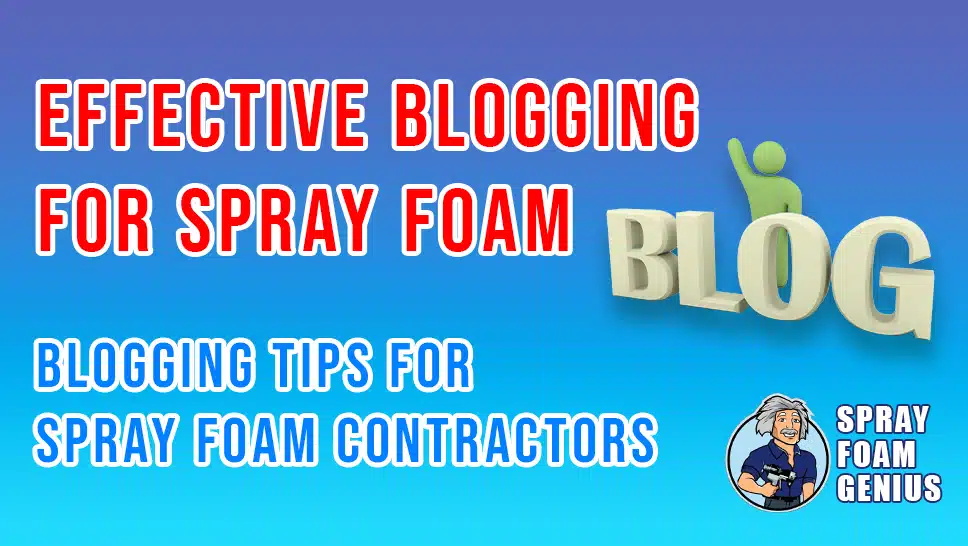
In the competitive realm of spray foam insulation, having a robust content marketing strategy is crucial. Blogging is a powerful tool that can enhance your online presence, attract potential clients, and establish your authority in the industry. At Spray Foam Genius Marketing, we specialize in helping spray foam contractors leverage blogging to boost their business. This comprehensive guide will explore effective blogging strategies specifically tailored for spray foam contractors, ensuring you harness the full potential of your blog.
Why Blogging Matters for Spray Foam Contractors
Benefits of Blogging
Blogging offers numerous benefits for spray foam contractors, including:
- Increased Visibility: Regular blogging helps improve your website’s SEO, making it easier for potential clients to find you through search engines.
- Establishing Authority: High-quality, informative content positions you as an expert in the spray foam insulation industry.
- Engaging with Your Audience: Blogging allows you to address common questions, provide valuable insights, and engage directly with your audience.
- Generating Leads: Effective blogs can drive traffic to your website and convert visitors into leads.
Crafting a Successful Blogging Strategy
1. Define Your Goals
What Do You Want to Achieve?
Before you start blogging, it’s essential to define your goals. Common goals for spray foam contractors include:
- Increasing Website Traffic: Attract more visitors to your website.
- Building Brand Awareness: Enhance your brand’s visibility and recognition.
- Generating Leads: Convert blog readers into potential clients.
- Establishing Thought Leadership: Position yourself as a knowledgeable leader in the industry.
Setting SMART Goals:
- Specific: Define what you want to achieve (e.g., increase website traffic by 20% in six months).
- Measurable: Identify how you will measure success (e.g., using Google Analytics).
- Achievable: Ensure your goals are realistic based on your resources.
- Relevant: Align your goals with your overall business objectives.
- Time-Bound: Set a timeframe for achieving your goals.
2. Know Your Audience
Understanding Your Readers
Knowing your target audience is crucial for creating relevant and engaging content. For spray foam contractors, your audience may include:
- Homeowners: Individuals looking to improve insulation in their homes.
- Commercial Property Owners: Businesses needing insulation solutions for commercial buildings.
- Builders and Contractors: Professionals seeking subcontractors or additional services.
Creating Audience Personas:
- Demographics: Age, location, income level.
- Needs and Pain Points: Common problems or questions related to spray foam insulation.
- Interests: Topics and issues your audience is interested in.
3. Choose the Right Topics
Relevant and Engaging Content
Selecting the right topics is crucial for attracting and retaining readers. Focus on topics that address your audience’s needs and interests. Here are some ideas for blog topics:
- How-To Guides: Step-by-step instructions on various aspects of spray foam insulation.
- Industry News: Updates on industry trends, technologies, and regulations.
- Case Studies: Real-life examples of projects and their outcomes.
- FAQs: Answer common questions about spray foam insulation and related services.
- Tips and Best Practices: Advice on maintaining insulation, choosing the right products, etc.
Keyword Research:
- Primary Keywords: Terms directly related to spray foam insulation (e.g., “spray foam insulation benefits”).
- Secondary Keywords: Related terms that support your primary keywords (e.g., “energy-efficient insulation”).
- Long-Tail Keywords: More specific phrases that target niche audiences (e.g., “best spray foam insulation for cold climates”).
4. Optimize Your Blog Posts
SEO Best Practices
To ensure your blog posts reach your target audience, optimize them for search engines:
- Title Tags and Meta Descriptions: Include primary keywords and craft compelling titles and descriptions.
- Headers and Subheaders: Use clear and descriptive headings (H1, H2, H3) to structure your content.
- Internal Linking: Link to other relevant pages or blog posts on your website to improve navigation and SEO.
- External Linking: Reference credible sources to enhance the authority of your content.
- Images and Alt Text: Use relevant images and include descriptive alt text for SEO.
Tools for SEO Optimization:
- Google Keyword Planner: Identify relevant keywords and search volume.
- Yoast SEO: A plugin that helps optimize your content for SEO.
- Google Analytics: Track blog performance and user engagement.
5. Promote Your Blog Posts
Reaching a Wider Audience
Promoting your blog posts helps increase visibility and drive traffic. Consider the following strategies:
- Social Media: Share your blog posts on social media platforms to reach a broader audience.
- Email Newsletters: Include blog highlights in your email newsletters to engage with existing subscribers.
- Industry Forums and Groups: Participate in relevant online communities and share your expertise.
- Guest Blogging: Write guest posts for industry-related websites to reach new audiences.
Promotion Tools:
- Hootsuite: Manage and schedule social media posts.
- Mailchimp: Create and send email newsletters.
- Reddit: Engage with relevant subreddits and share valuable content.
6. Measure and Analyze Performance
Tracking Success
To understand the effectiveness of your blogging strategy, regularly measure and analyze performance:
- Traffic Metrics: Track the number of visitors, page views, and bounce rates using Google Analytics.
- Engagement Metrics: Monitor metrics such as average time on page, comments, and social shares.
- Lead Generation: Evaluate how many leads are generated from your blog posts.
Adjusting Strategies:
- Content Performance: Identify which topics and formats perform best and adjust your content strategy accordingly.
- Audience Feedback: Incorporate feedback from readers to improve content relevance and quality.
- SEO Performance: Continuously refine your SEO strategies based on performance data.
Best Practices for Effective Blogging

1. Write Quality Content
Prioritize High-Quality Information
Quality content is key to engaging your audience and establishing authority. Focus on:
- Clarity: Ensure your content is clear, concise, and easy to understand.
- Relevance: Address topics that are important to your audience and provide actionable insights.
- Originality: Offer unique perspectives and solutions that set you apart from competitors.
2. Maintain a Consistent Posting Schedule
Regular Updates
Consistency is crucial for maintaining reader interest and improving SEO. Develop a content calendar to plan and schedule your blog posts.
Tips for Consistency:
- Set a Schedule: Decide how often you will publish new posts (e.g., weekly, bi-weekly).
- Plan Ahead: Use a content calendar to organize and plan your blog topics and deadlines.
- Stick to Deadlines: Ensure timely publication of your blog posts to build trust and reliability.
3. Engage with Your Readers
Building Relationships
Engaging with your readers helps build a loyal audience and encourages interaction.
Ways to Engage:
- Respond to Comments: Reply to comments and questions to foster a sense of community.
- Encourage Feedback: Invite readers to share their thoughts and suggestions.
- Conduct Polls and Surveys: Gather feedback to understand your audience’s needs and preferences.
4. Stay Updated with Industry Trends
Keeping Content Relevant
The spray foam insulation industry is continually evolving. Stay updated with the latest trends and developments to ensure your content remains relevant.
How to Stay Informed:
- Industry News: Follow industry news sources and publications.
- Professional Associations: Join industry associations and attend conferences or webinars.
- Competitor Blogs: Monitor competitor blogs to understand current topics and trends.
Transform Your Business Today!
Effective blogging is a powerful strategy for spray foam contractors looking to enhance their online presence, engage with their audience, and drive business growth. By implementing the strategies outlined in this guide, you can create valuable content that resonates with your target audience and sets you apart from the competition. At Spray Foam Genius Marketing, we specialize in helping spray foam contractors develop and execute successful blogging strategies. If you’re ready to take your content marketing to the next level, Call us at 877-840-FOAM for USA and 844-741-FOAM for Canada visit our website at sprayfoamgeniusmarketing.com, or email us at [email protected] to get started.
Let us help you leverage the power of blogging to achieve your business goals.
- 5 Google My Business Hacks to Double Your Leads for Spray Foam Insulation Contractors - January 14, 2025
- Why Spray Foam Contractors Cannot Ignore Reputation Management in 2025 - January 13, 2025
- Local SEO Secrets Every Spray Foam Contractor Must Know to Win in 2025 - January 13, 2025

